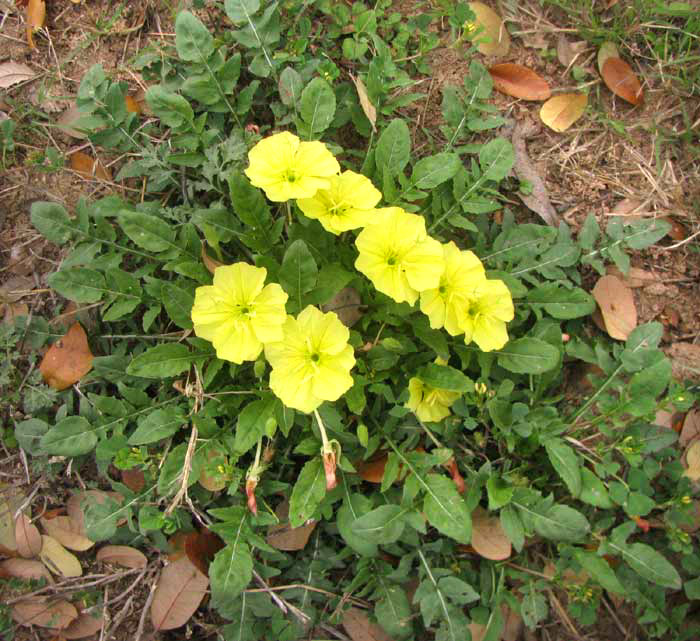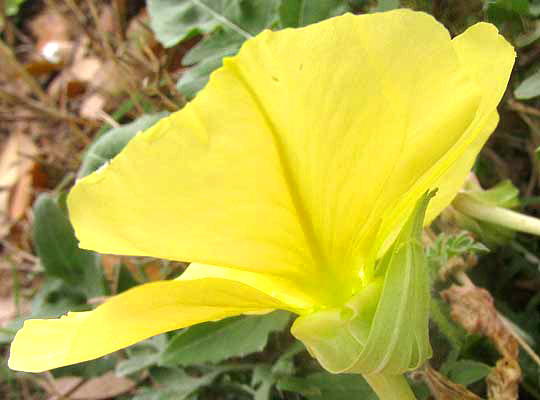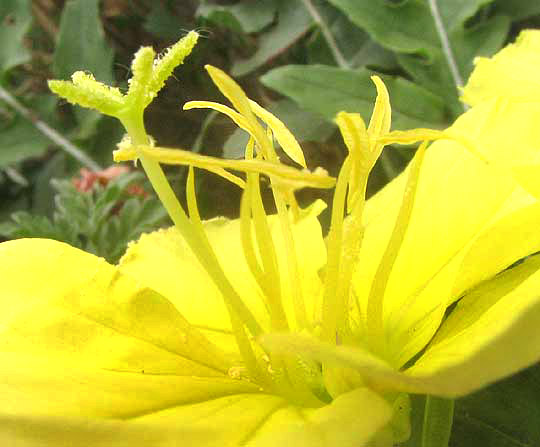Excerpts from Jim Conrad's
Naturalist Newsletter

from the March 9, 2014 Newsletter issued from the Frio Canyon Nature Education Center in the valley of the Dry Frio River in northern Uvalde County, southwestern Texas, on the southern border of the Edwards Plateau; elevation ~1750m (~5750 ft); N29.62°, W99.86°; USA
STEMLESS EVENING PRIMROSE
The most eye-catching "weed" now blossoming in many lawns in Uvalde is what's shown above. Of course that plant is so pretty that the name "weed" hardly applies, yet it does commonly grow in people's grassy lawns, and I did see where certain early mowers had run right over the gorgeous volunteers, chopping them to pieces. Sometimes the mowers' blades were set so high that only the flowers were sheared off, sparing the deeply pinnately lobed leaves, and some earlier-flowered blossoms, which tend to close up, turn pinkish and droop into the leaves once they've been pollinated, as you can see in the picture. The drooped flowers should produce fruits, which may explain why the plant persists year after year despite the mowings.
A peculiarity of the genus is that the flower's long, slender calyx lobes tend to stick together at their tips, forming a sort of flange pointed to one side, as shown below:

Another close-up showing eight stamens, which is normal for this group of plants, and a curious four-lobed stigma held above the stamens and to their side on a slender style, is seen below:

Most serious wildflower sniffers will recognize this combination of flower features as characteristic of the evening primroses, genus Oenothera. However, about 145 Oenothera species are recognized as native to the Americas, so which is this?
This particular evening primrose is distinguished by the fact that it's a winter annual, which means that its seeds germinate in the fall, the plant grows through the winter, and then when warm weather comes it flowers and fruits. Many winter annuals form ground-hugging circles of leaves known as basal rosettes, which is the case with this species. Our plant remains nearly stemless -- doesn't "bolt" in warmer weather, producing tall flowering stems as in some species. The deeply lobed leaves are characteristic, as is the fact that the four-lobed stigma is held above the stamens, not down among them. But one of the best field marks for this species is the mere fact that it is adaptable enough to thrive in frequently mowed grassy lawns, year after year. Few evening primrose species can do that.
Though plants do produce short, leafy stems, often it's referred to as the Stemless Evening Primrose. In Texas sometimes they call it Texas Buttercup, but buttercups are normally thought of as completely different plants. In other places it's the Dandelion-leaved Evening Primrose. It's OENOTHERA TRILOBA, a member of the Evening Primrose Family, the Onograceae, and it occurs in the US south-central states from Kansas and Missouri south, though it appears spottily farther east, plus it extends southward into central Mexico.
Stemless Evening Primrose is a native plant that, besides in people's lawns, also occupies many kinds of dry, open areas such as prairies, floodplains, slopes, hillsides, and rocky fields.
In our area, in my opinion, its greatest contribution is that of offering spectacular splashes of color in early spring, just when springy color is needed, and just where people are likely to see it. Among the Zuni people, however, the plant is medicinal, used externally for rheumatism and swelling, plus they grind the roots for food.